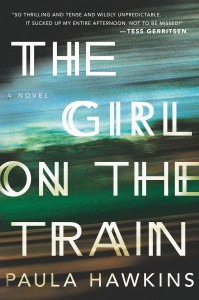The Girl On the Train
Paula Hawkins has been a professional journalist for more than fifteen years. She recently published the novel “The Girl On The Train” and it has become the new “it” novel, heralded as the next “Gone Girl”, last year’s “must read” novel, which I reviewed (positively) in an earlier edition of The Howler.
Being a bookstore owner, I need to know about these things, these popular new novels, these chance-taking authoresses. Before reading the press and doing my homework, I read the book and independently recognized the similarities with “Gone Girl”, sensed the similarities. Proclaimed them to customers as I read Paula’s book and drew conclusions on my own.
Female writer. Missing gorgeous woman. The story told in alternating chapters by independent characters.
But the similarities end there. Except that both have been wildly successful.
Rachel commutes from Ashbury every day on the same train into London, passing her former home, her first and only. She doesn’t focus on that so much anymore since her ex-husband and his new wife are living there. But she tries to check in on the backyard of the house just five spots down on the same road of a couple for whom she has proffered names (Jason & Jess) and admires, giving them each romantic jobs and a seemingly idyllic lifestyle.
In her fantasy. For twenty seconds. Every Monday through Friday when her commuter train passes her old haunts.
Since the divorce, Rachel boards in a single room with a sympathetic ex-college chum, is devastated by the abandonment of her husband and is now drinking way too much. She’s a wreck. Alcohol and depression are collectively taking over.
I admire Hawkins for her portrayal throughout the novel of the life of a person battling with alcohol and the social implications it bestows – in Rachel’s case as a credible witness. Because one day while commuting to the job Rachel barely possesses any more, she sees something, something irregular in the backyard of her idyllic couple. Has she been spying, snooping? The situation becomes serious without Rachel. Rachel’s dismissible, she’s a mess.
The twists and turns, the subplots and revelations keep the reader engaged but I believe that it is in the way the story is told, the signature and voice of the writer, which makes it engaging.
In writing this review I tried to do my homework but found it difficult to find much out about Paula’s history. Her guarded PR stated that this was her first plunge into modern pseudo-murder enthralling thrillers. I had to work hard to discover that she had written three trashy romance novels.
I commend her for that, for those, a trilogy that she claimed kept getting darker. I would wear them as insignia on my shoulder straps, like giant dazzling medals on my lapels if I were her.
Paula as authoress does a great job of constructing a story, leaving morsels of detail and creating subplots to dare the reader to turn the next page. For me, construction makes it all palatable
I am looking forward to her next release.

